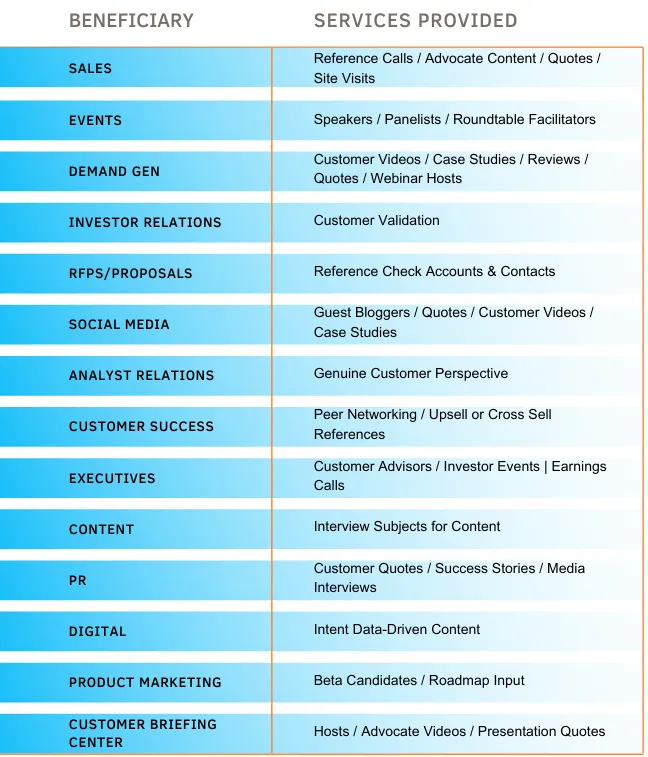
“Let’s be careful not to ask the Sales team to do too much.”
“CS already has a lot on their plate, let’s keep them out of this."
These are quotes from people in leadership roles when hashing out the processes and design of a customer advocacy program. On the surface, they sound like respectful, reasonable positions. But are they? Is the bigger picture being missed?
After the staff reductions over the past 12–18 months, it’s a safe bet that every department is trying to juggle the same amount of work with fewer people. It’s not really clear that Sales or CS are uniquely under resourced. But even if they are, effective customer advocacy offers these teams disproportionate efficiencies with a small investment of time to provide essential information they and they alone have.
But the bigger issue with these statements is that it’s presumed customer advocacy is some sort of burden, an over-and-above function; not a part of each stakeholder team’s responsibilities. That’s problematic, and just plain unfair.
The reason customer advocacy exists is to contribute to company growth through both acquisition and retention. Isn’t growth the end goal of every department in an organization? Customer experience is every employee’s responsibility. Great CX leads to advocacy. This quote, while from a B2C company, really sums up our belief.
“The purpose of a business is to create a customer who creates customers.”
– Shiv Singh, former Global Head of Digital at PepsiCo
Who benefits from a well-run customer advocacy program? It’s quite a list.

That’s a lot of value from a single function! Is it really possible to deliver on that promise? Yes! We see programs that are killing it every day. Here’s the catch: a program manager/team can’t know everything about every customer relationship. Intelligence from the field is essential.
– Who is a potential advocate and, precisely, for what?
– Which advocates are happy and available today?
– Who has left their position and is no longer an advocate?
– Are there are any service/technical issues affecting sentiment?
– Is the contract being renegotiated?
– Has anything about the account’s profile changed in the past 6 months?
Is it practical for the advocacy program to keep asking customers these questions to obtain regular updates? Most companies limit asking customers for information to NPS and customer satisfaction surveys. That’s a small portion of the information a customer advocacy program requires.
However, customer-facing team members have the answers to these, and many other questions of high relevance to an advocacy program manager’s ability to do their job. Without the answers, how can a program manager pull it off, especially a team of one? But the lives of our advocate contacts are fluid in ways that only relationship managers can stay on top of.
Given that the greatest beneficiaries of a customer advocacy program are also the people the program must rely on for a chunk of it’s intelligence, is their participation in the advocate ecosystem really a burden, an ask that goes above and beyond? Doesn’t the “Help me help you” rule apply here?
Now, do these statements really make any sense?
“Let’s be careful not to ask the Sales team to do too much.”
“CS already has a lot on their plate, let’s keep them out of this.”
We don’t think so. A change in perspective is in order. Without a clear-eyed understanding of the relationship between advocacy and the rest of the enterprise, a program will always be swimming upstream, never reaching its potential. And who will take the blame? The customer advocacy program, of course.
It’s easy to understand the hesitation with involving busy teams like Sales and Customer Success in your customer advocacy practices and processes. However, effective customer advocacy is an integral part of a strategy that supports the growth and efficiency of the entire organization. One element of a successful customer advocacy program lies in recognizing that advocacy is a collective effort, not the domain of one, discrete team. When teams collaborate and share essential customer insights, the program thrives, benefiting everyone involved.
By shifting our mindset and embracing customer advocacy as a core function intertwined with every department’s goals, we create a robust foundation for growth and customer satisfaction. The “help me help you” principle underscores the reality that participation in advocacy efforts is a shared pathway to mutual success. Adopt this philosophy and harness the true potential of customer advocacy to drive company success. Discover how our supplemental staffing services can enhance your customer advocacy program and improve overall company success.
